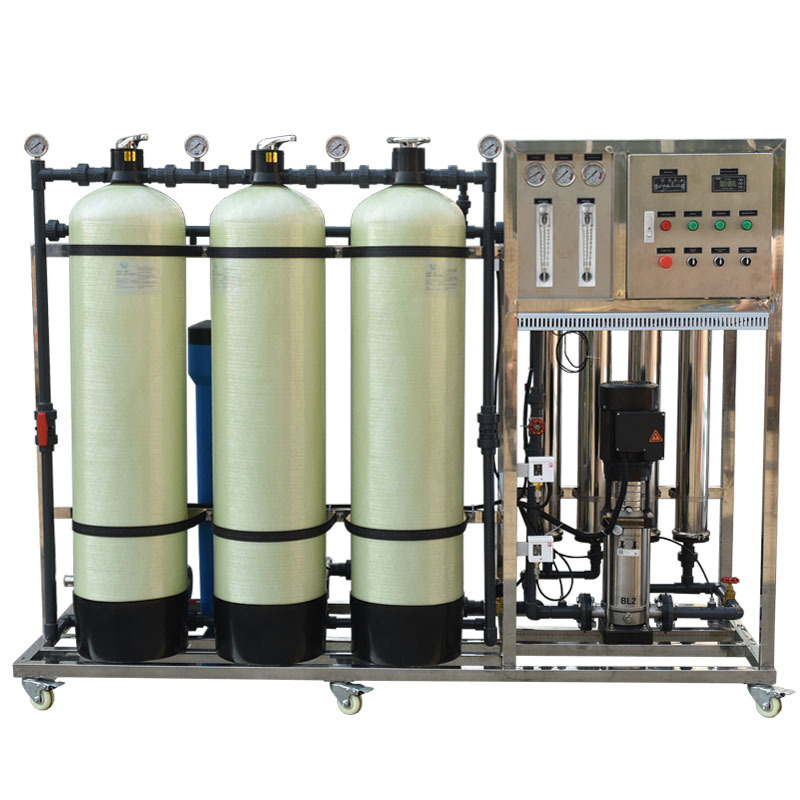Reverse Osmosis, RO for short, is one of the most effective water filtration systems available on the market. Osmosis is the process by which water moves over a semi-permeable membrane in an attempt to equalize a solution or suspension.
Reverse osmosis uses pressure to push water back over the same semi-permeable membrane, leaving bacteria, chemicals, dirt and other particles on one side and a reservoir of pure water on the other side.

RO Water Plant
While the principles of reverse osmosis are easy to explain, this article will look at how specific RO Water Plants work in the home, businesses, and large-scale industry.
An RO water filtration system uses multiple semi-permeable membranes in a series to progressively remove more of the impurities from the water on each step. This produces some of the safest and best tasting water at the tap.
Raw Water Tank
In any filtration system, you have to have a consistent flow of water to ensure the water flows over the filtering materials and membranes at a consistent rate.
Good RO systems will utilize a raw water tank attached to a raw water pump in order to facilitate controllable water flow rates.
Raw Water Pump
In combination with the water tank, the raw water pump ensures that there is consistent flow through the filtration system.
The Pre-Filter
The first stage of a four-step RO process is the pre-filter. This is a filter attached to the main water entry point. This filter is designed to prevent introduction of large contaminants into the system that will clog up the finer filters and membranes later in the process.
The pre-filter is often a sand filter, sand works better than charcoal at this stage because it can be in much larger particles, only filtering out the larger contaminants.
The Activated Carbon Filter
Carbon filters are also known as charcoal filters, and they are useful for filtering out many chemicals from water. While a pitcher with a built-in carbon filtration system is usually too fast to filter out much of the chloramines or chlorine, the carbon filter in a RO system takes longer to process the water and has more carbon that the water is filtered through.
The carbon filter stage is therefore essential to producing quality tasting water. Although there is some doubt as to the efficacy of carbon filters for removing chlorine and its compounds, most of those doubts come from filters that have neither as much carbon as an RO filter nor take as long for the water to filter through the carbon.
Softener
After the carbon filter, if there are any solutes within the water still, the water softener introduces Na and K ions which force more hard ions like Ca and Mg out of the solution.
This is desirable because Ca and Mg cause much of the corrosion and build up along pipes. Ca and Mg also make it difficult to rinse soap off, giving the feeling associated with hard water.
The final filter is fine activated carbon. This attempts to remove as much of the impurities as possible before sending the water through the RO membranes.
Precision filters can be rated for viruses and bacteria, so they function as a key part of any organization or home’s water safety plans.
RO Membranes
Finally, the reverse osmosis process goes through the membrane structures producing clean tasting and nearly pure water on the other end.
Although the water is nea rly pure, the is a slim chance that some bacteria or viruses have escaped through the process. RO membranes function as extremely small sifting devices that only allow water through from the high pressure to the low-pressure side. Because the water is being removed from the low-pressure side, the RO process continues as long as there is water flow.
Final Sterilization
The final sterilization stage of a RO water system is designed to ensure that there are no bacteria or viruses which can function and reproduce within the water. This can be an Ozone generator, where the radical Oxygen from 0zone is released into the water and attaches to the bacteria or viruses. Or, the final sterilization can be an UV light.
The UV light is at a certain frequency which scrambles DNA code. This scrambled code means that bacteria and viruses are unable to continue their growth and are rendered harmless.
For many cities and other large-scale water systems, they might reintroduce chlorine or chloramine into the water at this stage. One of the reasons larger systems require low amounts of these toxins is the fact that they will keep the water from ever developing bacteria or viruses.
Storage
Storing water after cleaning it is essential to maintaining a proper RO water filtration system. Most platforms put a RO water tank on the inside of the last filtration and sterilization process. That means that the water is as clean as possibly can be and tastes good too!
Some filtration systems will do finalized sterilization and then send the water to a storage tank outside the system. These are usually the larger filtration systems and often use chlorine or a chlorine derivative to ensure that bacteria do not enter the water environment any time between the filters and the end user. For smaller applications, final sterilization after the storage tank and immediately before it enters the water pipes is preferable.
Reverse Osmosis vs Plain Filtering
There are many filtration systems out there which remove offending bacteria and amoebas from the water. But, RO works to remove 99% of ions, of bacteria, and of other unpleasant ingredients.
Plain filtering on the other hand, is less consistent in the product and the amount of filter material needed to remove all the contaminates from the water mean that cleaning out the filtration system will take a significant amount of time.
Osmosis is a great system. And, depending on the size of the filters and the storage tanks, it is scalable to provide predictably clean water for any size organization or building. Whether purifying water for a municipality or for a single home, reverse osmosis will provide the best taste and purest water.
With over 10 years’ experience producing RO water tank systems, Ocpuritech is a professional producer of RO water tanks for home, business, and enterprise usage. If you are interested in purchasing and installing a full-size RO system for your home or business, please contact us today. For more information on RO systems, see our website.

